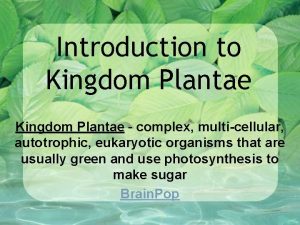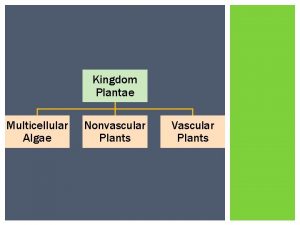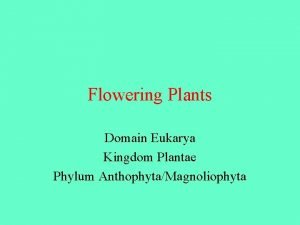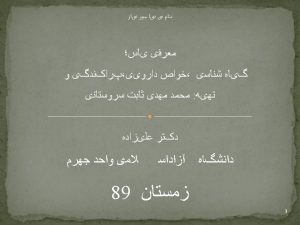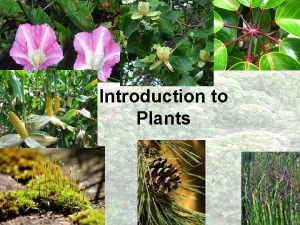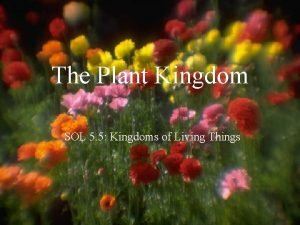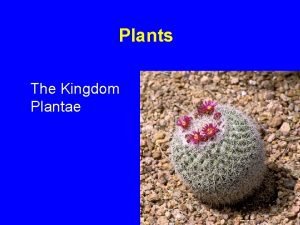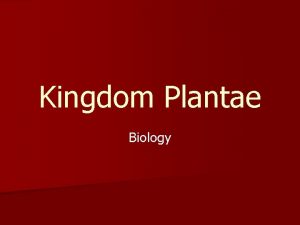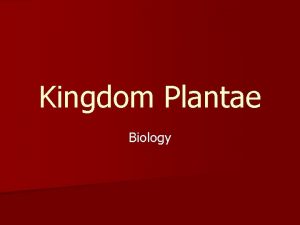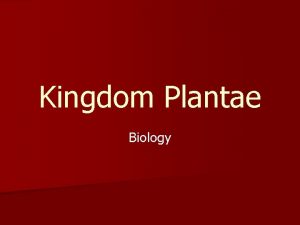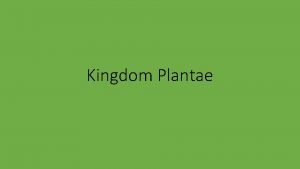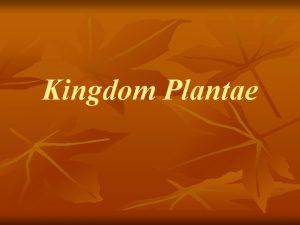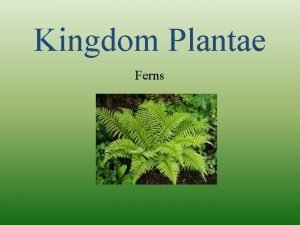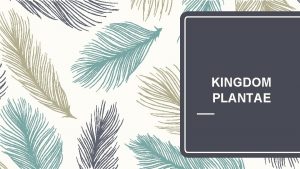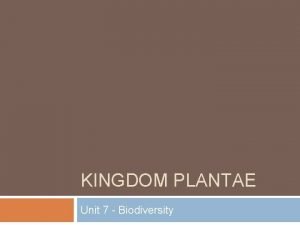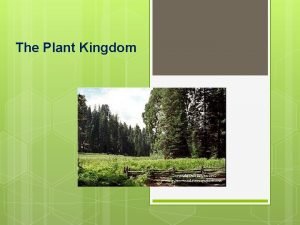Kingdom Plantae What Is a Plant l Multicellular


















- Slides: 18

Kingdom Plantae

What Is a Plant? l Multicellular eukaryotes that are photosynthetic autotrophs l Cell walls made of cellulose l Store surplus carbohydrates as starch l Mostly terrestrial

What do plants do? l All plants are alike in one way. – They need three things in order to survive • Water • carbon dioxide • energy from sunlight – What do you suppose the plants use these things for? Classify – to sort into groups based on similarities and differences

Cell Wall – What’s it for? Cell walls are only found around plant cells. l Cell walls are made of specialized sugars called cellulose. l It's like taking a water balloon and putting it in a cardboard box. The balloon is protected from the outside world. l Cell walls also help a plant keep its shape. While they do protect the cells, cell walls and cellulose also allow plants to grow to great heights. l Question: What is the composition of the cell was and where is it located in relation to the cell membrane?

a protective covering that surrounds the seed makes seeds. makes the plant's food. anchor the plant in place and absorb water and other minerals from the soil. carries water and food to the rest of the plant.

Obstacles Plants Overcome l Absorb Minerals l Conserve Water – Cuticle – Stomata – Guard Cells l Reproduce on Land

Plants: Grouped by characteristics l Vascular – Three main parts: roots, stems and leaves • Roots can be different sizes: – Fibrous and tap roots • Storage roots; beets, carrots, sweet potatoes and turnips – Roots have different functions: anchoring the plant, taking in water and minerals, and store food. l Nonvascular – Simple; most grow in moist places – No vascular tissues.

A Vascular System Enables Plants to Thrive on Land l Most plants need a “plumbing” system to transport water, minerals and nutrients. This system is known as the VASCULAR SYSTEM.

Water and Nutrient movement How Trees Absorb Water: l Water enters a tree through roots by osmosis and any dissolved mineral nutrients travel with it upward through the xylem (using capillary action) and into the leaves. l Ninety percent of tree water is eventually dispersed from leaf stomata, through evaporation, into the atmosphere. l That beneficial loss of water from plants is called transpiration. Transpiration video l Question: How do tree get water and nutrients from the soil to their tops?

Divisions of Living Plants Are Divided into Nonvascular and Vascular l There are 3 divisions of nonvascular plants – Hepatophyta – the Liverworts • Simplest of plants (gametophytes are dominate • Flat leafy body lacking cuticle, stomata, roots, stems or leaves – Anthocerophyta – the Hornworts • Dominate gametophyte and have stomata – Bryophyta – the mosses • Small, most have simple vascular tissue • Sporophyte with slender stalk and spore capsule • “leafy” green gametophyte that lacks roots, stems and leaves

Plants reproduce differently Reproduce – it means “to make more of the same kind” Plants are classified by characteristics. Plants that make seeds Flowering Plants Conifers Plants that do not make seeds Ferns Mosses

Evolution of the Seed l There are 5 phyla of living seed plants. Four of these phyla are collectively known as GYMNOSPERM - conifers l The other phyla is ANGIOSPERMS – flowering plants

What Are the Parts of a Flower l Most flowers have four parts Sepal – one of the leaflike parts that protects a flower bud and that is usually green Pistil – part of a flower that makes the eggs that grow into seeds Stamen – part of a flower that makes pollen – Flower parts Pollen – tiny grains that make seeds when combined with a flower’s egg

Flower Anatomy Draw this in your notes!!! What plant structures contains pollen?

How Fertilization Occurs l When a pollen grain reaches a pistil, it grows a thin tube to the ovary. Sperm from the pollen grain combines with an egg, and a seed forms. Fertilization – the combination of sperm from a pollen grain with an egg to form a seed

Some flowering plants are monocot seed – a seed that has one seed leaf and stored food outside the seed leaf dicot seed – a seed that has two seed leaves that contain stored food

Seeds MONOCOTS DICOTS Embryo with single cotyledon Embryo with two cotyledons Pollen with single furrow or pore Pollen with three furrows or pores Flower parts in multiples of three Flower parts in multiples of four or five Major leaf veins parallel Major leaf veins reticulated Stem vacular bundles scattered Stem vascular bundles in a ring Roots are adventitious Roots develop from radicle Secondary growth absent Secondary growth often present

 Multicellular autotrophic eukaryotic
Multicellular autotrophic eukaryotic Kingdom plantae characteristics
Kingdom plantae characteristics Kingdom of protist
Kingdom of protist Kingdom fungi and kingdom plantae similarities
Kingdom fungi and kingdom plantae similarities Youtube egypt
Youtube egypt Mentohotep
Mentohotep Old kingdom middle kingdom new kingdom
Old kingdom middle kingdom new kingdom Nnn ruled
Nnn ruled Kingdom plantae vascular and nonvascular
Kingdom plantae vascular and nonvascular Are all plants multicellular
Are all plants multicellular Eubacteria characteristics chart
Eubacteria characteristics chart Lilium longiflorum
Lilium longiflorum Introduction of kingdom plantae
Introduction of kingdom plantae Subkingdom of kingdom plantae
Subkingdom of kingdom plantae Lycodiophyta
Lycodiophyta Structure of kingdom plantae
Structure of kingdom plantae Plantae is prokaryotic or eukaryotic
Plantae is prokaryotic or eukaryotic Common characteristics of plantae
Common characteristics of plantae Biological classification worksheet
Biological classification worksheet
